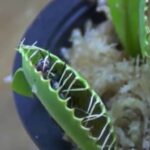As an Amazon Associate, this site earns commissions from qualifying purchases. For more details, click here.
Is your sundew no longer producing as much dew as before? Or has the plant dried up completely? A sundew that does not have dew means it is not growing properly, so you need to give it the right attention. This article explains what you have to do.
Lack of sunlight is the most likely reason why a sundew does not have dew. Other possible reasons are low humidity, high temperature and impurities in the water.
Lack of Light
Sundews need light to produce dew, or mucilage. Usually the tentacles are pinkish red but without enough light the color dissipates. You will not see any dew on the plant, only water minus the sticky part.
Solution. The remedy is to give the plant more sunlight. More sunlight means more dew, and you should see this after a few days or weeks.
Too much intense light might also lead to low dew production however. The high temperature and heat might stress the sundew and cause it to temporarily stop producing mucilage. When the temperature drops, it will try to resume though this might take a while.
Place your sundew plant under shade during the hottest part of the day. If you are growing sundews indoors make sure it has access to light, natural or artificial.
Sundews will grow with artificial options like the Wolezek Plant Light for Indoor Plants and can even help boost dew production.. If you are using artificial light, check how the plant responds. If dew appears, keep doing it. If production slows or nothing shows up, reduce the light intensity or add humidity to its location.
Poor Air Circulation and Humidity
Good airflow is important but too much of it can actually lead to loss of dew. So you need to strike the right balance here.
Proper air circulation is required in high humidity to prevent fungus from spreading. Sundews also benefit from airflow when the temperature climbs into the 90s and higher because it leads to greater cooling. But too much air will cause dew to dry up.
Solution. Some sundews grow with little to no air circulation. This is fine if the temperature is within the acceptable range. But during intense heat, make sure the plant is in an area that receives some air flow.
If your sundew is indoors you can use a humidifier such as the Levoit 6l. This is very useful during hot summer days when the sun is very intense or there are strong winds.
If you do not want to use a humidifier, there is always the tray method. Put your sundew pot in a tray and fill it with an inch or so of water.
Add more water when the level goes down. During summer the roots will soak up the water quickly so make sure the tray does not dry out. If you planted your sundew in a deep container, you can add two inches of water.
The key is the soil as it needs be constantly moist. Sundews love water and if there is no dew, a combination of sunlight and water will help. Of course you must not overwater the plant, but during summer sundews will require lots of it.
Temperature Too High
Sundews prefer a temperature range of 45 to 85 F (7 to 29 C). They can tolerate a few degrees higher, but intense heat leads to rapid dew loss.
The dew or mucilage contains water, and the hotter the temperature, the more water a sundew has to produce. The high temperature evaporates water faster so the dew disappears quickly.
Under intense heat, sundews have to constantly produce water and mucilage, but the heat leads to rapid evaporation. If the plant cannot keep up its production, you will see fewer amounts of dew on the leaves.
Solution. If your plant is outdoors, move it under shade. During summer the heat reaches its peak at noon up to early afternoon. All you need to do is relocate the plant before noon and restore to its original location later.
If there is an extended heat wave, keep your sundew under shade as too much heat is bad for plants. Make sure the plant receives nutrients from insects, freeze dried mealworms or fish food.
During hot summer days, sundews need nutrition to maintain dew production. If you moved the plant from its original spot to one with fewer insects, feed it manually, but do not overfeed.
Impure Water
Using tap water on sundews is one of the reasons why dew disappears. Tap water contains salts and other minerals that are not good for sundews and plants in general.
Tap water is readily available which is why most people use it. The problem is the water contains chlorine, which is not good for sundews. If your tap produces hard water that means it contains plenty of minerals that could be dangerous to sundews.
Solution. Use only purified, reverse osmosis or rainwater. This ensures the plant gets the freshest and most natural water possible. This will not only increase dew production but also ensure your sundew is in good health.
Acclimatization
If you are going to buy a sundew, keep in mind that it will need time to get used to your home. Everything will be different from its previous location: the humidity, heat, temperature, food, etc.
Solution. Under these circumstances, it is understandable why a sundew might not produce any dew. It could simply be adjusting to its new home. Give the plant a few weeks to get used to its surroundings.
First make certain your sundew is under the right conditions (enough light, water, right soil etc.). If everything checks out and there is still no dew, you just need to be patient. Assuming the plant does not get sick, you will see dew soon enough.
Root Rot
Root rot makes it difficult for sundews to generate dew. As the rot spreads, dew production stops completely. Its leaves start to turn brown or black and could be fatal to the plant.
Solution. Cut off the rotted parts and repot the rest of the healthy sundew. Plant in a deep container and use nutrition free soil. Make sure the tray has enough water and the pot container good drainage. This can take a while to produce results so you have to be patient.
How to Increase Dew on Sundews
Aside from what has already been mentioned, there are other things you can do to keep your plant healthy and with plenty of dew.
Fix soil problems quickly. Anaerobic soil means too much moisture as a result of overwatering. Because sundews need a lot of water, overwatering occurs. The solution is to use just enough water to keep the soil moist without being watery.
Avoid soil compaction. The soil has become too dense and water cannot drain out. The roots get clogged and causes rotting. Eventually this affects the health of the plant and makes it hard to create dew.
There are two solutions. One is to discard the water tray method and top water the plant. The other is to repot your sundew. Replace the soil with a new mix (1:1 peat moss and perlite ideal) and plant your sundew again.
Regular feeding. Sundews need to eat at least one insect a month or up to a maximum of four or five. When the plant receives enough nutrients, it will have more resources available to make dew.
Keep the plant in a stress free environment. By stress free, that means plenty of sunlight, just enough water, air movement and nutrients. With these four elements your sundew should remain healthy and strong.
Do not play with your sundew.. Sundews are not toys. Do not play with the mucilage. Do not feed it human food to see what will happen. Do not poke the tentacles with your finger to see if it will hurt you. This is not good the sundew.
Conclusion
If your sundew has no dew, you need to take action. The good news is that it is not too late. Once you have figured out the reason why there is none, you can remedy the situation and with patience, you should see those dew spring up again.

My fascination with carnivorous plants began many, many years ago with Venus Fly Traps. Now I am more than happy to impart what I know with other enthusiasts and those who are curious about meat eating plants.



